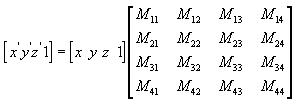
| DirectX SDK |
In programs that work with 3-D graphics, you can use geometrical transformations to:
You can transform any point into another point by using a 4×4 matrix. In the following example, a matrix is used to reinterpret the point (x, y, z), producing the new point (x', y', z'):

Perform the following operations on (x, y, z) and the matrix to produce the point (x', y', z'):

The most common transformations are translation, rotation, and scaling. You can combine the matrices that produce these effects into a single matrix to calculate several transformations at once. For example, you can build a single matrix to translate and rotate a series of points. For more information, see Matrix Concatenation.
Matrices are written in row-column order. A matrix that evenly scales vertices along each axis (known as uniform scaling) is represented by the following matrix (using mathematical notation):

In C++, Direct3D Immediate Mode declares matrices as a two-dimensional array, using the D3DMATRIX structure. The following example shows how to initialize a D3DMATRIX structure to act as a uniform scaling matrix:
D3DMATRIX scale = {
D3DVAL(s), 0, 0, 0,
0, D3DVAL(s), 0, 0,
0, 0, D3DVAL(s), 0,
0, 0, 0, D3DVAL(1)
};
In Visual Basic, Direct3D Immediate Mode uses matrices declared as a two-dimensional array, using the D3DMATRIX type. The following example shows how to initialize a variable of type D3DMATRIX to act as a uniform scaling matrix:
Dim ScaleMatrix As D3DMATRIX
' In this example, s is a variable of type Single.
With ScaleMatrix
.rc11 = s
.rc22 = s
.rc33 = s
.rc44 = 1
End With